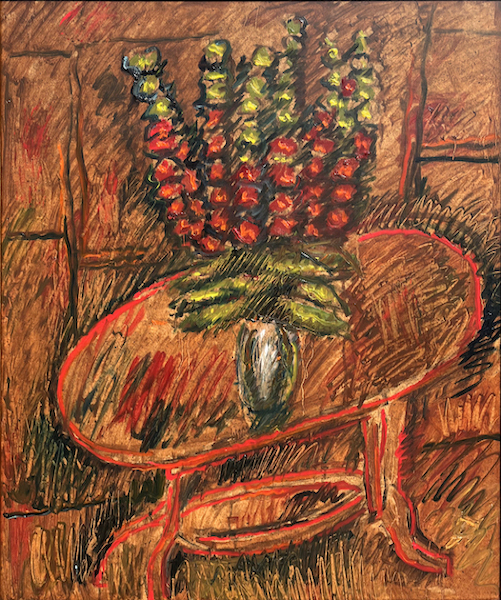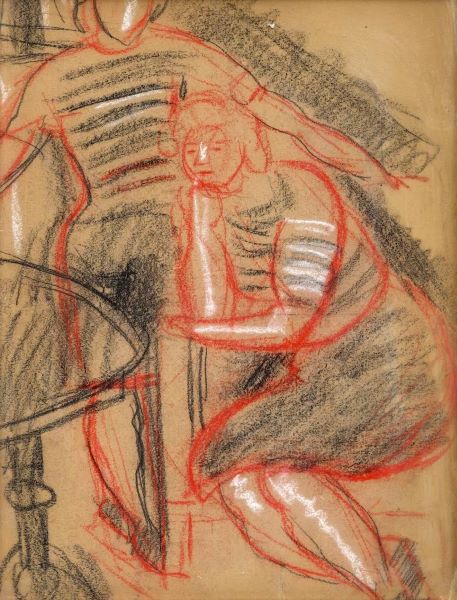Biography
He was born on January 13, 1903 in Budapest, in a bourgeois family. At the age of two, he was temporarily mute and paralyzed due to meningitis and lost his hearing. With the help of his mother and his own willpower, he learned to talk and walk again by the age of six.
At first, he finished his elementary school privately, then he finished the III. as a regular student. district Áldás utca Municipal Elementary School. He consciously trained himself because he didn't want to appear weaker than his peers. He liked to read, he learned German and English, he wanted to know the world, he was most interested in tragic stories. At the age of fourteen, he "wrote a novel" about his illness, after which his interest turned to painting. His drawing talent was discovered by his maternal uncle Artúr Elek, the short story writer and art critic of the West, who encouraged him to learn drawing. His first teacher was Róbert Novotny. In 1920/21, he took the matriculation exam at the Hungarian Royal Bolyai High School in Budapest's 5th district. At the same time, he studied at the Akácfa utca free school, he attended a course with Gyula Derkovits and Róbert Berény.
He started the Hungarian Academy of Fine Arts in 1921, but did not finish until 1928, because in the meantime he attended the Heyman Free School in Munich in 1922-23. In 1924, he worked at the artist colony in Nagybánya, since his college master, István Réti, was one of the founders of this artist colony. He also had his first exhibition this year, with great professional success. In the early thirties, he went on a study trip to Berlin, Paris and Vienna. In these places, he supported himself as a professional boxer so that he could draw to his heart's content. He was in constant training to keep his will "awake", even after the age of seventy, he boxed daily.
In 1932, together with his father, Vilmos Román, he started a chocolate-drape production company in Shanghai. Due to the constantly humid climatic conditions, their stocks were destroyed, due to bankruptcy, his father returned home, but he ensured his living by drawing and boxing, and only returned home in 1937, when he heard of his mother's illness. The time spent in the Far East is a frequently recurring motif in both his works of writing and painting.
At home, he formed a significant circle of friends from artists, primarily Miklós Gábor, who gladly promoted his works and opened his exhibitions, and sculptor Dezső Bokros Birman, who was his tablemate at the Luxor Café, but their family friend was Beck Ö. Philip too.
In 1942, in Vasas Szécház on Magdolna Street, he exhibited his dramatic pictures with Socialist artists, but the exhibition was closed by the police. His creative career started with this fiasco.
In 1944, he suffered a great loss: his uncle Artúr Elek committed suicide due to the Jewish laws that came into force. From that time on, he also hid in the vicinity of Pásztó, because he was called up for labor service, and then survived the siege in Buda.
He then collected his hidden pictures and books and moved into the home of his deceased parents on Falk Miksa Street. During this time, he participated in ten group exhibitions and was professionally recognized. His literary work developed after 1945, also in regularly published magazines.
He got married in 1947, his wife, Erzsébet Orosz, was the daughter of the manager of the former Horthy estate in Gödöllő, their only child, Katalin, was born in 1948.
His novel Asia Port, published in 1951, was met with incomprehension by the press, which is why he lost interest in creative work as an artist and worked as a proofreader at Szépirodalmi Könyvkiadó for ten years. His volume of short stories published in 1958, The Rebellion of the Liliputs, was crowned with professional success.
He was not a creative person who could be confined to schemes in his literary work either. Expressive and surrealistic mood elements, dreams and visions appear in his pictures. The visionary dreams of his childhood illness, the nausea and joys of his youthful travels provided the themes.
From 1958 until his death, he spent two weeks of every summer in the Szigliget Creative House of Hungarian Writers. He finished his two novels here: The gray house and The inhabitants of the black mountains. He also regularly painted oil paintings here, and from 1963, oil pastel and watercolor paintings of Szigliget and the Balaton highlands were created here. His autobiographical novel entitled A máanyyól was published this year, but the "masterpiece" of his life, the novel The Traveler of Sickness, written between 1937-1968, could only be published after his death, in 2003.
In 1973, he was awarded the gold degree of the Order of Merit for his work as a painter and writer.
In 1979, Hungarian Television made a documentary about him, entitled From loneliness, directed by Márta Kende. In his lifetime, he had five large representative solo exhibitions, with serious professional success, without state orders. However, art collectors, thanks to the painter's friend Lili Ország, have already discovered and sought out her works.
In 1980, the art historian János Frank wrote a book about his painting. He could still read the manuscript of the book, but he could no longer afford the 1982 publication. He died of a stroke on September 1, 1981, in Budapest.
(source: https://www.romangyorgy.hu)




